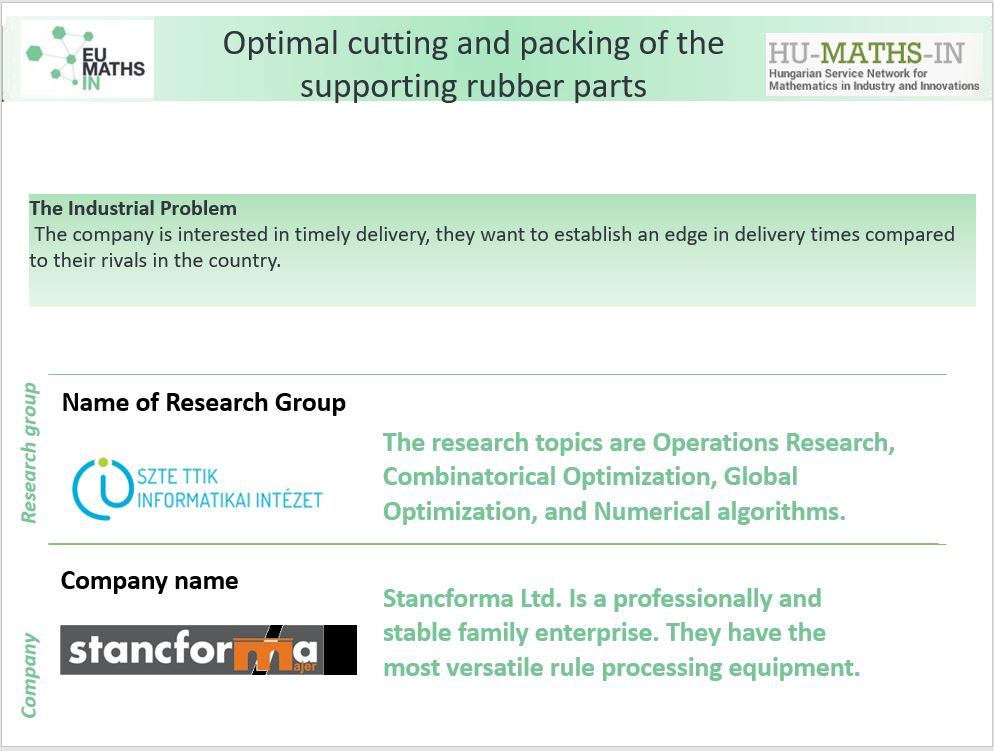Optimal cutting and packing of the supporting rubber parts for punching health- and transportation industrial goods
 Kutatás vezetője: Bánhelyi Balázs
Kutatás vezetője: Bánhelyi Balázs
Intézmény: University of Szeged
Leírás: Adott egy a partner cég vágószerszámának terve CAD rendszerben Elkészítettünk egy programot, amely képes a CAD rendszer adatainak feldolgozására, és ad egy jobb vágási tervez a gumi alkatrészekre, amellyel az anyagköltség és az alkatrészek könnyebb azonosítása hatékonyabb. Ezen előny lényeges pont aszállítási időkben, ami döntő jelentőségű ebben a rendkívül versenyképes ipari ágazatban
Adott egy a partner cég vágószerszámának terve CAD rendszerben Elkészítettünk egy programot, amely képes a CAD rendszer adatainak feldolgozására, és ad egy jobb vágási tervez a gumi alkatrészekre, amellyel az anyagköltség és az alkatrészek könnyebb azonosítása hatékonyabb. Ezen előny lényeges pont aszállítási időkben, ami döntő jelentőségű ebben a rendkívül versenyképes ipari ágazatban.
Our partner firm is able to manufacture stripping and broaching tools, combined and perforating rules of special sizes. With the stripping tools, the hydraulic press machines are cutting the boxes from the laminated box paper. The tool is based on a wooden table, which has cutting blade inserts. Stripping tools contain a rubber next to the blades. This rubber holds the paper still while the hydraulic machines are pressing the blades into the material. The rubber forms are created by a custom design software automatically. From the manufacturing point of view cutting these large shapes with low infill is inconvenient or impossible and heavily increases costs. To minimize waste and handle larger shapes than the stock material, the rubber parts are cut to smaller pieces in the design by workers. The smaller pieces are re-positioned with the help of the CAD software minimizing the left over costly material. By solving this non-trivial optimization problem, the pieces can be easily manufactured with much less waste and are easy to assemble on the wooden plates.
Using a CAD software to manually alter the original design is labor intensive and possibly a task that can be automated. Our goal was to automate and speed up the cutting of the rubber design while the waste and the assembly time of the tables is reduced or at least not increased much. These aims are competing with each other, we need to find a good balance. The cutting has to produce pieces that are the same on repeated structures and have a minimum amount of difference when two parts are only similar. This greatly helps to avoid making mistakes during the assembly. We also have to consider that packing algorithms work faster when the input pieces are smaller in number and have better results with more rectangular shapes.
Our automatic technique aims to give a solution for these challenges. We integrated the cutting and packing of the shapes into a single software for easier use. The algorithm cuts the rubber to small pieces which are easy to pack with small amounts of waste. This is not optimal for the assembly process, therefore the smaller pieces have to be merged into parts that are reasonable to assemble. A gluing process is used to produce the desired shapes for assembly which are possible to pack efficiently. Packing the rubber on stock material has a side effect with the used nesting algorithm. While the waste material between the pieces is acceptable, the bounding rectangle for the packing has significantly more. Because of the fast packing algorithm we are able to use iterative search for the optimal size of the used material. This restricts the packing to a more optimal solution considering the size of the bounding rectangle.


